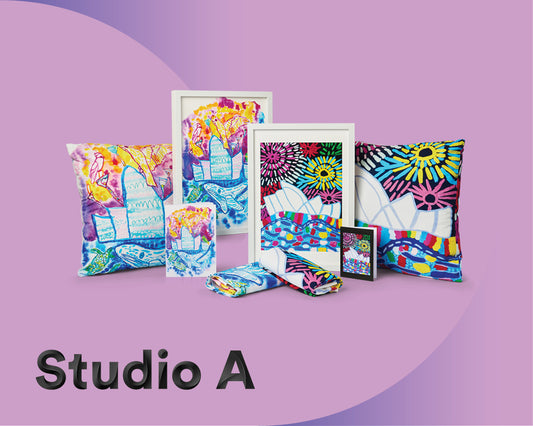Upcycled Glassware, a business that breathes new life into discarded bottles and transforms them into unique, handcrafted pieces, has earned itself a place in the fifth edition of the Sydney Opera House Uncovered program – a platform that showcases Australian makers and creators in the Opera House Shop.
Sister-in-laws and co-founders, Tanya Reinli and Amanda Cohen, share their creative business journey, their passion for sustainability and their excitement about their upcoming Uncovered collection.
Tell us a bit about yourselves and how Upcycled Glassware came to be.
Tanya: I'm a multidisciplinary artist working in sculpture, painting and glass. After completing my Bachelor of Visual Arts with Honours at the University of Sydney in 2019, my husband and I set up a glass studio. He's incredibly handy and built most of our machines from scratch using repurposed parts, or by refurbishing old machines – some of which are over 50 years old! When COVID hit, I started experimenting with discarded bottles, which is how our business really began. I'm drawn to upcycling because of the urgent need to repurpose mass-produced and single use items.

What are your roles in the business?
Tanya: I like to think that Amanda is the backbone of the business and I focus on the creative side, specifically the production and design of the glassware.
Amanda: I handle most of the back end of the business – communications, the website, accounts and even some of the design work for our packaging with my brother Matt (Tanya’s husband). Even though I utilise my corporate background at Upcycled Glassware, I’ve always been concerned with sustainability. Combined with my deep admiration of Tanya’s work, I knew it was the right move.
“One of my favorite things about using upcycled glass is that each bottle has a story, whether it’s a San Pellegrino bottle that traveled from Italy or an Australian wine bottle enjoyed by a local Sydneysider.”

How do you source the recycled glass you use in your pieces?
Tanya: We source glass from all over, but we’re lucky to have local businesses that drop off bottles at our studio in Botany. Sourcing the same type of bottle can be difficult, especially when we want to create a collection. For example, we worked with the Yarra Bay Sailing Club to collect their beautiful ice-blue bottles, which were then turned into tumblers for the Opera House’s Uncovered collection. We couldn’t do what we do without these suppliers, as they carefully store the bottles – a process that many restaurants wouldn’t bother with because the glass has to be treated delicately. If there's any microtrauma to the glass, it could explode during production.
Amanda: One of my favourite things about using upcycled glass is that each bottle has a story, whether it’s a San Pellegrino bottle that travelled from Italy or an Australian wine bottle enjoyed by a local Sydneysider.
“I'm drawn to upcycling because of the urgent need to repurpose mass-produced and single use items.”
What’s involved in the tumbler production process?
Tanya: Once we’ve sourced the bottles, we start by soaking them for 24 hours to remove the labels. The next step is hot popping, a technique where we score the glass and then apply heat using our converted microwave transformer. When you dip the bottle in cold water, small explosions occur in the glass, causing the scored parts to pop off.
Before we had an industrial kiln, I would spend hours hand-polishing the tumblers. But now, thanks to my husband’s work on the kiln, we’re able to fire polish them. The process involves applying heat to the top ring of the glass and spinning it until the rim melts and forms a smooth, strong edge. Afterward, the glass goes into an annealer to distress the glass and ensure it doesn’t crack.
It’s a process I’ve refined over time and have learnt a few lessons the hard way. I still have scars from the early days of glass explosions!
It’s definitely a labour of love but I’ve learnt to not get too attached to any piece because it could easily break after hours of production.

What’s your favorite piece in the Opera House Uncovered collection?
Tanya: It’s hard to pick just one because I think they all have their unique beauty and purpose. What I love about working with upcycled glass is that each piece is one-of-a-kind. The different colours and shapes of the glass ensure there’s something for everyone to appreciate.
What does being featured in Uncovered mean to both of you?
Amanda: Being featured in Uncovered 2025 at the Sydney Opera House is a huge honour. It’s such an amazing platform and we love that it aligns with our values of sustainability and mindful consumption. We’ve always aimed to highlight the beauty that’s often unseen in discarded materials, so it’s wonderful for that message to be shared nationally. We hope it helps bridge the gap between appreciating sustainable products and actually choosing them.

Shop the Upcycled Glassware collection
Find out more about Uncovered.



